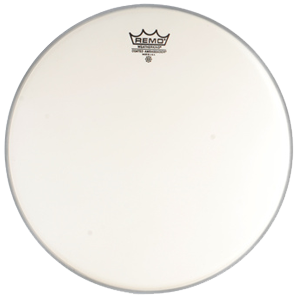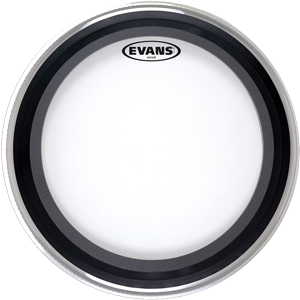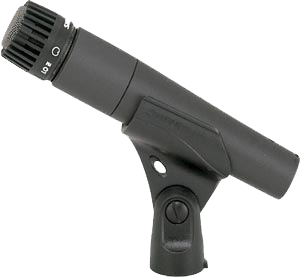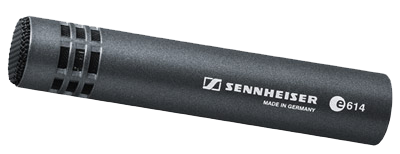Drums
Record a drums
There are many ways to record drums. I will present one to you, not necessarily the best but the easiest to approach for a beginner. With affordable equipment references.
THE DRUMS
This is the most important part of this article. Your instrument must already “sound” without having gone through your computer. Your sound recording can be magnificent, your microphones overpriced, your software over-powerful, if the basic sound is rotten only a magician will be able to get something out of it.
The skins must be new or lightly played. A new skin will have a brighter sound with more resonance while an old skin will be more difficult to tune, the note will be less sustained.
The most famous skins are:
- Remo Pinstripe – A short, fat and deep sound on the toms – Rock, pop, Metal. (55€ pack 12″, 13″, 16″)

- Remo Ambassador coated – A reference for snare drums. (15€ for a snare drum 14″)

- Evans Emad – For bass drum – Warm tone, deep response. (47€ in 22″)

Tune your drums. this is the second step. Drumheads (for the note) and timbre (for resonance and a little bit of the note too). The more you tighten, the sharper it is. You can consult the article Drum sound to give you an idea of the sounds to look for on toms, bass drums and snare drums.
If you find that your toms resonate too much, take some paper towel and some wide tape (ideally gaffer tape), make a 20cm strip along the strapping on the skin. It’s not very aesthetic but very effective. The larger the band, the less the skin will resonate. You can also try doing this on the resonance head.
For the bass drum, place a pillow or blanket inside to touch the 2 heads.
Once your instrument is ready, tackle the technical part of the recording.
MICROPHONES
The microphones I’m going to tell you about are affordable, reliable and proven. But the choice of a microphone is above all a matter of taste and budget.
- Tom-tom: Sennheiser E604. Very practical because it is equipped with a clamp which attaches directly to the tom rim, it will avoid having a bulky microphone stand. It is also very robust and will withstand blows from chopsticks. (Price: 125€)

- Snare drum: Shure SM57. It can be placed on top or bottom of the snare drum using a microphone stand. It has exceptional sound, unrivaled robustness and proven reliability every day. The sound is clear and soft, quite close to reality. (Price: 110€)

- Bass drum: AKG D112. To be placed inside the bass drum or in front of the resonance head. It has a very nice bass sound. (Price: 160€)

- Hi-hat and overheads: Sennheiser E614. A static all-terrain microphone (requires 48V phantom power). It offers a faithful and precise rendering in a very wide bandwidth, it captures the sounds of the different cymbals with a crystal clear rendering. (Price: 175€)

Some brands now offer microphone packs including toms, snare drums, bass drums and overhead microphones such as AKG, Shure, Beyerdynamic or less expensive T-Bone. Prices range from €300 to €2000.
HOW MANY MICROPHONES DO YOU NEED?
At least for a correct sound recording on a standard drum kit, you will need 8 microphones:
1 bass drum
1 snare drum on it
1 by toms (3)
1 hi-hat
2 overheads (ambient microphones)
You can also add a microphone under the snare drum.
Don’t forget to invest in microphone stands. For our example, you need 5. (15€ per foot)
HOW TO PLACE THE MICROPHONES?
There are also several possibilities, start very simply by placing the microphone 2 fingers from the head for the snare drum and toms. 4 fingers from the hi-hat cymbal. And well above the drums, symmetrically for the overheads.
THE SOUND CARD
This is the element that will form the link between your battery and your computer. For our example, you need to take a card that has at least 8 XLR inputs with the possibility of having a 48V phantom power supply. You can find them from 400€. It’s an investment…
With few exceptions, they all work with PC and Mac. Pay attention, depending on your computer, to the USB or Firewire connection.
While writing this article, I realized that some brands have created mixers that connect via USB, be careful, most only offer a stereo output of your mix.
The 8 channels must arrive separately on your computer.
I could give you references but things are evolving so quickly that as soon as this article is released it would already be obsolete. Find out more at a music store or by browsing the internet.
DAW: DIGITAL AUDIO WORKSTATION
Today still called DAW (Digital Audio Workstation), it is the software that will manage the recording of your drums in multitracks via the sound card.
You can, after recording, correct your music by, for example, correcting certain keystrokes. This is called editing. But also add effects to the tracks (reverb, delay, compression, etc…), work on the equalization (more or less serious).
These software allow you to stack a lot of tracks, so you can add percussion, bass, guitars… according to your inspirations and create a real piece of your own.
Until a few years ago, recordings were made on very expensive magnetic tapes. This system allows you to record, erase, cut as many times as you want. The only limit is your imagination!
The DAW best known to the general public are:
LOGIC PRO X – Apple – 180€ – Mac
CUBASE 7 – Steinberg – 269€ – Mac and Windows
STUDIO ONE – Presonus – 230€ – Mac and Windows
For professionals:
PRO TOOLS 10 – Avid – 569€ – Mac and Windows
DIGITAL PERFORMER – Motu – 491€ – Mac and Windows
CONCLUSION
Good preparation of the drums, good, well-placed microphones, a sound card with at least 8 XLR inputs, a DAW and you are ready for quality recording at home.
Let us listen to your productions!

